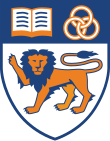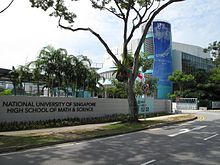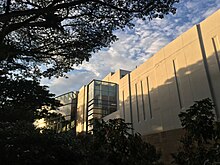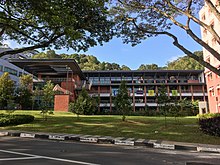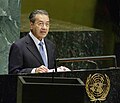|
National University of Singapore
The National University of Singapore (NUS) is a national public research university in Singapore. It was officially established in 1980 by the merger of the University of Singapore and Nanyang University.[5] The university offers degree programmes in disciplines at both the undergraduate and postgraduate levels, including in the sciences, medicine and dentistry, design and environment, law, arts and social sciences, engineering, business, computing, and music.[6] NUS's main campus is located adjacent to the Kent Ridge subzone of Queenstown.[7] The Duke–NUS Medical School is located at the Outram campus.[8] The Bukit Timah campus houses the Faculty of Law and Lee Kuan Yew School of Public Policy. NUS's affiliated faculty members and researchers include one Nobel Prize laureate,[9] one Tang Prize laureate, and one Vautrin Lud laureate.[10] History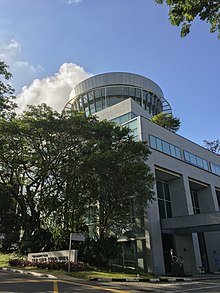 In September 1904, Tan Jiak Kim led a group of representatives of the Chinese and other non-European communities to petition the governor of the Straits Settlements, Sir John Anderson, to establish a medical school in Singapore.[11] It was noted by Anderson that there were other petitions prior which were not successful due to concerns over having a sufficient number of students and support from the local community.[12] Tan, who was the first president of the Straits Chinese British Association, managed to raise 87,077 Straits dollars from the community, including a personal donation of $12,000.[12][13][14] On 3 July 1905, the medical school was founded and was known as the Straits Settlements and Federated Malay States Government Medical School. At Anderson's directions, the school was hosted temporarily at a recently emptied block at a Government-run asylum in Pasir Panjang while providing the staff required to run the school.[12] In 1912, the medical school received an endowment of $120,000 from the King Edward VII Memorial Fund, started by physician Lim Boon Keng. Subsequently, on 18 November 1913, the name of the school was changed to King Edward VII Medical School. In 1921, it was again changed to King Edward VII College of Medicine to reflect its academic status.[15][16] In 1928,[17] Raffles College, a separate institution from the medical school, was established to promote education in arts and social sciences.[18] University of Malaya in Singapore (1949–1962)On 8 October 1949, Raffles College was merged with King Edward VII College of Medicine to form the University of Malaya. The two institutions were merged to provide for the higher education needs of the Federation of Malaya.[19] The growth of University of Malaya was very rapid during the first decade of its establishment and resulted in the setting up of two autonomous divisions in 1959, one located in Singapore and the other in Kuala Lumpur.[19] Nanyang University (1955–1980)In 1955, Nanyang University (abbreviated Nan-tah, 南大) was established on the backdrop of the Chinese community in Singapore.[7] University of Singapore (1962–1980)In 1960, the governments of then Federation of Malaya and Singapore indicated their desire to change the status of the divisions into that of a national university.[11] Legislation was passed in 1961, establishing the former Kuala Lumpur division as the University of Malaya, while the Singapore division was renamed the University of Singapore on 1 January 1962. Present formThe National University of Singapore (NUS) was formed with the merger of the University of Singapore and Nanyang University on 6 August 1980.[20] This was done in part due to the government's desire to pool the two institutions' resources into a single, stronger entity and promote English as Singapore's main language of education. The original crest of Nanyang University with three intertwined rings was incorporated into the new coat-of-arms of NUS.[21] Most departments of the university were situated at the Bukit Timah campus, with the gradual shift to the Kent Ridge site starting in 1969 and completed in 1986. NUS began its entrepreneurial education endeavours in the 1980s, with the setting up of the Centre for Management of Innovation and Technopreneurship in 1988. In 2001, this was renamed the NUS Entrepreneurship Centre (NEC), and became a division of NUS Enterprise. NEC is currently headed by Wong Poh Kam[22] and its activities are organised into four areas, including a business incubator, experiential education, entrepreneurship development and entrepreneurship research. NUS has 17 faculties and schools across three campus locations in Singapore – Kent Ridge, Bukit Timah and Outram. NUS also collaborates with many other Universities around the world, such as Harvard University,[23] Yale University,[24] UCLA,[25] and Georgia Institute of Technology.[26] Coat of armsThe coat of arms of the National University of Singapore was adopted in 1980 and modernised in 2001. It is the combination of the coat of arms of the former University of Singapore used since 1962 (consisting of an open book and a lion, which itself was derived from the former coat of arms of the University of Malaya used from 1949 until 1962, which featured a tiger instead of a lion), and the emblem of the former Nanyang University, three interlocking rings but without the star used since 1955.[27][28][29] It is blazoned:
The lion represents NUS as a Singaporean university, the open book represents knowledge and the three rings represents the university's role in creating, imparting and applying knowledge, as well as creativity, innovation and entrepreneurship. The National University of Singapore is one of two public universities in Singapore to adopt its coat of arms, alongside the Nanyang Technological University, with which it has relations. Reputation and rankings
Overall RankingsGlobally, NUS was #8 in the QS World University Rankings 2025,[38] #19 in the Times Higher Education (THE) World University Rankings 2024,[39] #22 in the USNWR 2024–2025 Best Global Universities Rankings,[40] #68 in the Academic Ranking of World Universities (ARWU) 2024,[41] #29 in the SCImago Institutions Rankings 2020,[42] and #26 in the Informatics Institute/METU's University Ranking by Academic Performance (URAP) 2022–2023.[43] NUS was the 27th best-ranked university worldwide in terms of aggregate performance across THE, QS, and ARWU, as reported by ARTU 2023.[44] QS has ranked NUS among the world's top 15 since 2016. THE has ranked NUS among the world's top 30 since 2013. The joint THE–QS World University Rankings from 2004 to 2009 ranked NUS globally 18th (2004), 22nd (2005), 19th (2006), 33rd (2007), 30th (2008 and 2009). NUS was 19th in the THE World Reputation Rankings 2022,[45] and was named the world's 10th most international university by THE in 2023.[46] The World's Top 2% Scientists by Stanford University features numerous NUS researchers from a wide range of disciplines.[47][48][49][50] Subject/Area RankingsIn the 2024 QS World University Rankings by Subject, NUS ranked among the global top 10 for 19 subjects.[51] In the 2025 QS Global MBA Rankings, NUS ranked 25th globally. [52] In the 2024 Times Higher Education (THE) World University Rankings by Subject, NUS achieved high global ranks in several subjects, being ranked 11th in Computer Science, 9th in Engineering, 11th in Law, and 15th in Business & Economics. In all subjects, NUS held the top spot nationally.[53] In the 2023 Academic Ranking of World Universities (ARWU) Global Ranking of Academic Subjects, NUS exhibited strong global standing, being ranked among the global top 30 in 22 subjects.[54] In most subjects, NUS achieved a national rank of 1.
NUS's performance in the Business School Rankings by Financial Times:[55]
Graduate Employability RankingsNUS graduates ranked 8th worldwide in the Times Higher Education's Global University Employability Ranking 2022,[56] and 17th worldwide in the QS Graduate Employability Rankings 2022.[57] Academic StructureNUS has a semester-based modular system for conducting undergraduate courses. It adopts features of the British system, such as small group teaching (tutorials) on top of regular two-hour lectures, and the American system (course credits). NUS has 17 faculties and schools across three campuses, including a music conservatory.[58] University Scholars ProgrammeThe University Scholars Programme (USP) was an undergraduate academic programme established in 2001 in NUS, which comprised a compulsory general education programme. USP admitted 240 undergraduates annually.[59][60] USP students resided in Cinnamon College at the NUS University Town.[59] This programme has since merged with Yale-NUS to become the NUS College.[61] NUS CollegeA modernized version of the University Scholars Programme, the NUS College today serves as the university's honors college, with a more rigorous application and a focus on global citizenship. The NUS College program notably involves foreign, service-based exchange around South-East Asia, guided by their core ideal that "Learning is a contact sport."[62] Faculties and SchoolsBusinessThe NUS Business School was founded as the Department of Business Administration in 1965. Today, the school has over 280 distinguished faculty members and a vibrant community of 7,000 students, and is a recognised leader in business education and research across Asia.[63] The NUS Business School ranks 3rd in Asia for Financial Times Global MBA Rankings 2024 and 1st in Asia-Pacific for QS Executive MBA Rankings 2024. NUS Business School offers a transformative experience for learners of all ages with programmes such as BBA, MSc, MBA, Executive MBA, PhD and Executive Education and collaborated with overseas universities such as Peking University, HEC Paris, CEMS and Yale University.
ComputingThe School of Computing established in 1998, has two departments: Computer Science; and Information Systems and Analytics.[64][65] DentistryThe Faculty of Dentistry traces its origins in 1929 as a Department of Dentistry within the King Edward VII College of Medicine.[66] The faculty conducts a four-year dental course leading to a Bachelor of Dental Surgery degree. Design and EngineeringThe interdisciplinary College of Design and Engineering (CDE)[67] was established in 2021, bringing together two pre-existing faculties, the School of Design and Environment (SDE) and the Faculty of Engineering (FoE). The School of Design and Environment has three departments: Department of Architecture; Department of the Built Environment; and the Division of Industrial Design.[68] The Faculty of Engineering was established in 1968. It is the largest faculty in the university, and consists of several departments spanning diverse engineering fields. Humanities and SciencesThe interdisciplinary College of Humanities and Sciences (CHS)[69] was established in 2020. It comprises the two largest faculties, the Faculty of Arts and Social Sciences, and the Faculty of Science, though both faculties are still branded independently, unlike CDE.[70] The Faculty of Arts and Social Sciences has roots in Raffles College. Initially offering just four subjects: English, History, Geography and Economics, the Faculty now offers majors, minors and special programmes across 16 Departments.[71] This includes the Centre for Language Studies, which teaches 13 different languages, and the Office of Programmes, which houses multidisciplinary fields and minor programmes.[72] The South Asian Studies Programme is not officially classified as a department, but as a departmental entity.[73] The Faculty of Science comprises multiple departments, spanning across natural and applied sciences. The first female Dean of the Faculty of Science was Gloria Lim, who was appointed in 1973. She served a four-year term and was reappointed in 1979, but resigned after one year to allow Koh Lip Lin to continue his post. In 1980, University of Singapore merged with Nanyang University to form NUS, resulting in overlapping posts.[74] Integrative Sciences and EngineeringThe NUS Graduate School for Integrative Sciences and Engineering (NGS) was established in 2003. The principal purpose of NGS is "to promote integrative PhD research encompassing both laboratory work and coursework programmes which not only transcend traditional subject boundaries but also provides students with a depth of experience about science and the way it is carried out."[75] LawThe NUS Faculty of Law was first established as a Department of Law in the University of Malaya in 1956. The first law students were admitted to the Bukit Timah campus of the university the following year. In 1980, the faculty shifted to the Kent Ridge campus, but in 2006 it relocated back to the Bukit Timah site.[76] The faculty offers LLB, LLM, JD, and PhD programmes, alongside continuing education and graduate certificate programmes. MedicineThe Yong Loo Lin School of Medicine at NUS was first established as the Straits Settlements and Federated Malay States Government Medical School in 1905. The School uses the British undergraduate medical system, offering a full-time undergraduate programme leading to a Bachelor of Medicine and Bachelor of Surgery (MBBS). For Nursing, the Bachelor of Science (Nursing) conducted by the Alice Lee Centre for Nursing Studies is offered. The department also offers postgraduate programmes in nursing, medicine, and medical science.[77] Duke–NUS Medical SchoolThe Duke–NUS Medical School (Duke–NUS) is a graduate medical school in Singapore. The school was set up in April 2005 as the Duke–NUS Graduate Medical School, Singapore's second medical school, after the Yong Loo Lin School of Medicine, and before the Lee Kong Chian School of Medicine. The Duke–NUS Medical School is a collaboration between Duke University in North Carolina, United States and the National University of Singapore.[78] MusicThe Yong Siew Toh Conservatory of Music (YSTCM) is a collaboration between NUS and the Peabody Institute of Johns Hopkins University. Singapore's first conservatory of music, YSTCM was founded as the Singapore Conservatory of Music in 2001. The School was renamed Yong Siew Toh Conservatory of Music after a gift was made by the family of the late Dr Yong Loo Lin in memory of his daughter.[16] Public HealthThe Saw Swee Hock School of Public Health is Singapore's first and only tertiary education institution for public health.[79] The school traces its origins to the University of Malaya's Department of Social Medicine and Public Health, formed in 1948.[80] Public PolicyThe Lee Kuan Yew School of Public Policy was established in 2004 as an autonomous graduate school of NUS. Although the School was formally launched in 2004, it inherited NUS's Public Policy Programme, which was established in 1992 in partnership with Harvard University's Kennedy School of Government.[81] Yale-NUS CollegeThe Yale-NUS College is a liberal arts college in Singapore established in August 2013 as a joint project of Yale University and the National University of Singapore. It is an autonomous college within NUS, allowing it greater freedom to develop its own policies while tapping on the existing facilities and resources of the main university.[82] Students who graduate receive a degree awarded by NUS.[82] Pericles Lewis, a former professor at Yale, was appointed as the founding president in 2012.[83][84][85][86] In August 2021, NUS announced that it was going to merge Yale-NUS College with the University Scholars Programme to form a new honours college, NUS College, by 2025.[87][88] The merger marks the dissolution of NUS's partnership with Yale University. The last class of Yale-NUS College students were those admitted in 2021, following which Yale-NUS would operate for several years until all of its students have graduated.[89] Teaching centresNUS has a variety of teaching centres including:
NUS High School of Mathematics and ScienceNUS High School of Mathematics and Science is a school specialising in mathematics and science, and provides secondary and pre-tertiary education to students with inclinations to these fields.[96][97] ResearchThe major research focuses at NUS are biomedical science, physical science, engineering, nanoscience, material science, information technology, humanities, social sciences, and defence.[98][99][100] One of several niche research areas of strategic importance to Singapore being undertaken at NUS is bioengineering. Initiatives in this area include bioimaging, tissue engineering and tissue modulation.[101] The university has received a number of grants from the Bill & Melinda Gates Foundation for research into areas including vaccine development,[102] water treatment,[103][104] mobile devices in healthcare,[105] iris recognition,[106] synthetic antibodies,[107] tuberculosis,[108] and government response to the COVID-19 pandemic in Asia.[109] Research institutes and centresCurrently, NUS hosts 21 university-level research institutes and centres (RICs) in various fields. Four of these RICs have been designated Research Centres of Excellence by the Singapore government — the Cancer Science Institute of Singapore, Centre for Quantum Technologies, Mechanobiology Institute, and Institute for Functional Intelligent Materials.[110] Besides university-level RICs, NUS also affiliates with other universities to establish research centres and institutes.[111] The Logistics Institute – Asia Pacific is a collaborative effort between NUS and the Georgia Institute of Technology for research and education in logistics.[112] The Next Age Institute, a partnership with Washington University in St. Louis, is the most recent cross-university centre involving NUS, established in February 2015.[113] EntrepreneurshipNUS began its entrepreneurial education endeavours in the 1980s, establishing the Centre for Management of Innovation and Technopreneurship in 1988. In 2001, this was renamed the NUS Entrepreneurship Centre (NEC), and became a division of NUS Enterprise, the entrepreneurial arm of NUS. Its activities include entrepreneurial education and outreach, technology commercialisation, and a business incubator.[114][115] The NUS Overseas Colleges (NOC) programme was started in 2001, giving students the opportunity to experience, live, work and study in an entrepreneurial hub. Participants of the programme either spend 6 months or a year overseas, taking courses at partner universities and working in start-ups.[116] The NUS Industry Liaison Office (ILO) is another department that is involved in the creation of deep tech start-ups. It manages the university's technology transfer and promotes research collaborations with industry and partners. ILO manages NUS intellectual property, commercialises its intellectual assets and facilitates the spinning off of technologies into start-up companies.[117] Campus facilities and resourcesNUS's main campus is located in the southwestern part of Singapore, adjacent to the Kent Ridge subzone of Queenstown, accommodating an area of 170 ha (420 acres).[7] The Duke–NUS Medical School, a postgraduate medical school jointly established with Duke University, is located at the Outram campus;[8] and its Bukit Timah campus houses the Faculty of Law and Lee Kuan Yew School of Public Policy.
IT and computing servicesNUS hosts NUSNET, an intranet, which is used in research, teaching, learning and administration. In 2004, a campus-wide grid computing network was deployed, connecting at least 1,000 computers. At the time, it was one of the largest of such virtual supercomputing facilities in the region.[118] LibrariesThe NUS Libraries currently comprises seven libraries: the Central Library, Wan Boo Sow Chinese Library (Chinese: 雲茂潮中文图书馆), C J Koh Law Library, Hon Sui Sen Memorial Library, the Medicine+Science Library, Music Library and Yale-NUS College Library.[119] As of June 2017, there were 2,354,741 unique titles, and 26,074 microform resources[120] in the collection.[121] This has since expanded to 3,018,572 unique physical titles, 94,446 electronic periodicals, 1,244,448 electronic books and 936 databases, as of 2022.[122]
Digital Gems digital newspaper archive databaseDigital Gems digital newspaper archive database was established by the National University of Singapore NUS Library and contains various digitized collections, including Chinese-language newspapers published in Southeast Asian countries in the 19th and 20th centuries. Currently, 152 types are included, including Chinese newspapers from Singapore and Malaysia. The newspaper collection is the most abundant. In addition, the platform also includes many historical documents on China and overseas Chinese in Southeast Asia. Most of these documents are publicly accessible resources and are open to readers around the world for online reading, downloading and printing. They provide valuable information for scholars who are committed to Southeast Asian history and overseas Chinese research. Access to historical materials.[123] In addition to newspaper archives, this database also contains periodicals and books from the 20th century and is available to the public for free. Types of newspapersChinese newspapers from six Southeast Asian countries from 1887 to 1985, such as Singapore, Malaysia, Brunei, Indonesia, the Philippines and Thailand. There are also newspapers in English and Malay from Singapore and Malaysia. Other documentsSingapore Law Documents (1867–1962), Singapore and Malaya Medical Journals and Books (1911–1959), Malay Literature (1812–2017), Pre-war and post-war Japanese studies of Southeast Asia (1889–1954), Historical map of Singapore (1846–2010) and Singaporean and international private documents. Singaporean and international private documentsFamous Singaporean actor Yan Boyuan (Bai Yan) (born and died from 1920 to 2019) CarlA. Trocki, Australian historian of Southeast Asia and China Carl Anthony Trocki (born and died 1940–2024) British Southeast Asian biologist Gathorne Gathorne-Hardy (1933-) Malaysian banker Yeap Chor Ee (born and died 1867–1952) Personal documents of WangZengshan (born and died 1903–1961), the head of the Chinese Islamic Mission to the Near East (1937–1939) and the Director of the Civil Affairs Department of the Xinjiang Provincial Government of the Republic of China (1945–1949). How to useJust go to the official website of the National University of Singapore Library and click "Digital Gems", scroll down on the main page, then click on the Chinese newspaper entry among the entries, then click on the nationality of the newspaper, and finally click on the one you are looking for The newspaper type and time are completed. Website linkhttps://digitalgems.nus.edu.sg/ University TownThe NUS University Town (UTown) opened in August 2011. Located at the Kent Ridge campus, it was built on the site of a former golf course.[124] UTown hosts four residential colleges, a graduate residence,[125] the Yale-NUS campus, research institutes (such as the TUM CREATE), lecture theatres, restaurants, convenience stores, and a barber shop.
TransportationThe university has a free Internal Shuttle Bus system that operates across the Bukit Timah and Kent Ridge campuses.[126] In late 2022, the university started to deploy electric bus in partnership with CDG.[127]
Student accommodationNUS has three types of student accommodation: halls of residence, student residences, and residential colleges. There are about 6,000 residential places distributed between halls of residence and student residences on campus, in addition to around 4,100 students who live in the residential colleges and graduate residences.[128] Halls of residenceNUS has 7 Halls of Residence with about 3,000 residential places. A points system, based on co-curricular activities and leadership roles, is used to allocate residential places to students. Halls have their own interest groups and student productions in addition to university-wide student co-curricular activities. Halls compete with each other in the Inter-Hall Games.[129] The Halls of Residence are:[130]
Student residencesNUS has two student residences — Prince George's Park Residences and UTown Residences — for undergraduate and graduate students.[131] The residences are arranged in clusters of 11 to 15 single rooms, with shared kitchen and bathroom facilities. The UTown Residences also has apartments for students.[132] Residential collegesNUS also houses residential colleges, which are modelled after the college systems of universities. Like halls, residential colleges have unique co-curricular activities. Residential colleges also have their own academic programmes, with general education requirements differing from each other and the rest of the university. The academic programmes in residential colleges take place in seminars.[133] Cinnamon College/West WingCinnamon College housed the University Scholars Programme (USP) until the 2021 intake. Together with the current Yale-NUS College Campus (which has been renamed the "West Wing"), the college will house the NUS College from the 2022 intake onwards. USP students and faculty are accommodated in 600 rooms.[134] Tembusu CollegeTembusu College was the second residential colleges in NUS University Town. Tembusu houses mainly first and second-year undergraduates, in addition to resident faculty, visiting scholars and graduate fellows.[135] The former founding Rector of Tembusu College is Singapore's Ambassador-at-Large and former United Nations Ambassador Tommy Koh, who is also the former dean of the NUS Faculty of Law.[136] College of Alice & Peter TanThe College of Alice & Peter Tan (CAPT) is a Residential College for all NUS undergraduates which emphasises active citizenship and community engagement. It provides a two-year academic programme.[137] Residential College 4Residential College 4 (RC4) is another Residential College in NUS with a thematic focus of systems thinking. Engineering Scholars Programme students are offered accommodation at this RC.[138] Ridge View Residential CollegeRidge View Residential College (RVRC) was formally established in April 2014, housed in the former Ridge View Residences. It is the only residential college that is situated outside University Town. The site was the former location for Kent Ridge Hall until November 2002. In November 2015, an annexe building to RVRC was constructed. It was completed in February 2017.[139] Vice-Chancellors & PresidentsBelow is a list of presidents throughout the history of the National University of Singapore (and its predecessors).[140] The office of the President of Raffles College was renamed Principal of Raffles College from 1938.[141]
Notable alumniSince its inception in 1905, NUS has had many distinguished alumni from Singapore and Malaysia, including two Singapore Prime Ministers and four Singapore Presidents, two Malaysian Prime Ministers, and many politicians, judiciaries, business executives, educators and local celebrities. It counts among its graduates, heads of state/government Abdul Razak Hussein, Benjamin Sheares, Goh Chok Tong, Mahathir Mohamad and S. R. Nathan. The first prime minister of Singapore, Lee Kuan Yew, attended Raffles College briefly prior to World War II. A number of its graduates are also notable politicians such as Rais Yatim,[142] Malaysia's former Minister of Information, Communications and Culture, Ng Eng Hen, Singapore's Minister for Defence,[143] Vivian Balakrishnan, Singapore's Minister for Foreign Affairs, and S. Jayakumar, Singapore's former deputy prime minister.[144] Many of Singapore's business leaders come from NUS, including as former chairman of the Singapore Exchange, and Singapore Tourism Board Chew Choon Seng,[145] CEO of the Hyflux Group Olivia Lum,[146] former CEO of the Temasek Holdings Ho Ching,[147] Chairman of SPRING Singapore Philip Yeo[148] and CEO of Razer Inc Min-Liang Tan.[149] In international politics, NUS counts among its graduates former director-general of the World Health Organization Margaret Chan,[150] former president of the United Nations Security Council Kishore Mahbubani,[151] and vice-president of the International Olympic Committee Ng Ser Miang.[152] NUS had served as Singapore's only law school for half a century, until the SMU School of Law was set up in 2007. Many of Singapore's judges and lawyers come from the school. This includes Singapore's Minister for Law, and Home Affairs K. Shanmugam,[153] the fourth Chief Justice of Singapore Sundaresh Menon[154] and the third chief justice of Singapore Chan Sek Keong.[155] In academia, NUS faculty include former vice-president of finance for the University of Virginia, and Cornell University Yoke San Reynolds,[156] and former vice-chancellor of the University of Hong Kong Wang Gungwu.[157]
See also
References
External links
|
|||||||||||||||||||||||||||||||||||||||||||||||||||||||||||||||||||||||||||||||||||||||||||||||||||||||||||||||||||||||||||||||||||||||||||||||||||||||||||||||||||||||||||||||||||||||||||||||||||||||||||||||||||||||||||||||||||||||||||||||||||||||||||||||||||||||||||||||||||||||||||||||||||||||||||||||||||||||||||||||||||||||||||||||||||||||||||||||||||||||||||||||||||||||||||||||||||||||||||||||||||||||||||||||||||||||||||||||||||||||||||||||||||||||||||||||||||||||||||||||||||||||||||||||||||||
